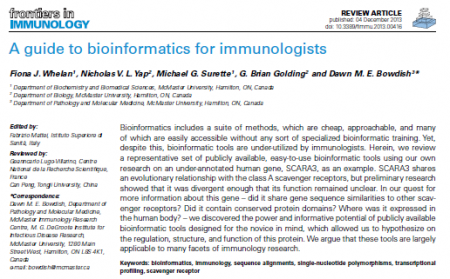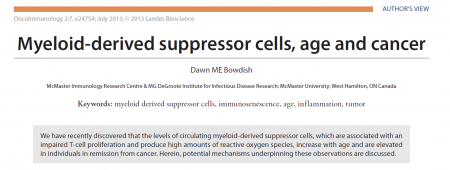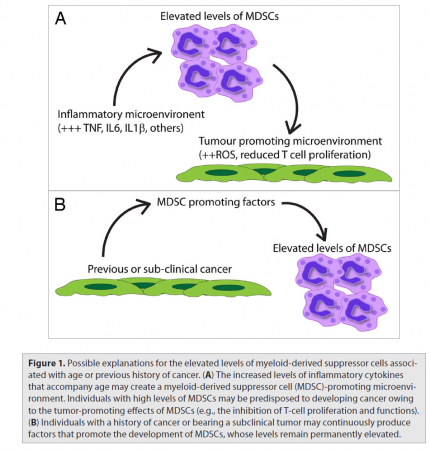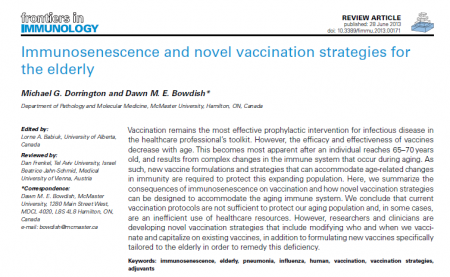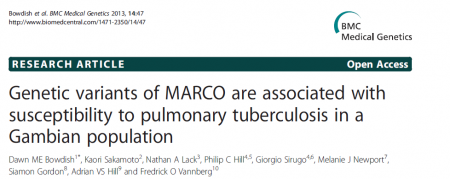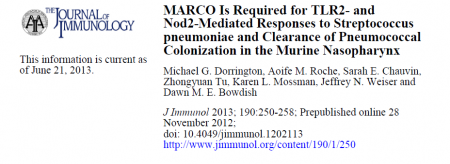PrabhuDas M, Bowdish D, Drickamer K, Febbraio M, Herz J, Kobzik L, Krieger M, Loike J, Means TK, Moestrup SK, Post S, Sawamura T, Silverstein S, Wang XY, El Khoury J. Standardizing scavenger receptor nomenclature. J Immunol. 2014 Mar 1;192(5):1997-2006. doi: 10.4049/jimmunol.1490003.
Tag Archives: manuscript
Puchta et al. Characterization of inflammatory responses during intranasal colonization with Streptococcus pneumoniae. Vis Exp. 2014 Jan 17;(83):e50490. doi: 10.3791/50490.
Puchta A, Verschoor CP, Thurn T, Bowdish DM. Characterization of inflammatory responses during intranasal colonization with Streptococcus pneumoniae. J Vis Exp. 2014 Jan 17;(83):e50490. doi: 10.3791/50490.
Whelan et al. Bioinformatics for Immunologists. Front Immunol. 2013 Dec 4;4:416. eCollection 2013.
A guide to Bioinformatics for Immunologists
Congratulations to Fiona Whelan (MSc, Bowdish lab; PhD student, Surette lab) for publishing the review article “A guide to bioinformatics for immunologists” in Frontiers Immunology. The idea of this article spawned from the research that Fiona conducted in the Bowdish lab on the elucidation of the evolutionary history and relationships between the members of the class A scavenger receptors, proteins required for host defense and homeostasis. During this time, Fiona used multiple bioinformatic techniques and tools to form hypotheses as to the function of one under-annotated member of this family, SCARA3. Even though most of these tools are easy-to-use and require little computational knowledge, Fiona and Dawn discovered through their interactions with other immunologists that these tools were being under utilized. Thus, they decided to write a review of how bioinformatic techniques can help the average immunologist in their quest for knowledge about the structure of their protein of interest, how to find SNPs that may correlate with disease phenotype, and how to conduct sequence alignments in order to find areas that are conserved across various genes.
This review article is written as a case study that follows Fiona’s research into SCARA3 that begins with obtaining the NCBI Reference FASTA sequence of the protein, predicting post-translational modifications, identifying conserved motifs, hypothesizing as to the structure of the protein, examining SCARA3’s transcriptomic profile in different immunological cell types, and analyzing any potential SNPs within the DNA sequence of SCARA3 that may correlate with disease. The article is written with the immunologist in mind and includes the use of only “point and click” tools that require no computational background whatsoever.
Is Fiona’s paper is Open Access? Of course it is! Enjoy reading it here and reading the description on the Surette lab website here.
The laboratories of both Dr. Bowdish and Dr. Surette are always interested in undergraduate and graduate students interested in exploring the impact bioinformatics can have on immunological and microbiological research.
“Myeloid-Derived Suppressor Cells, Age & Cancer” 2013. Oncoimmunology.
Dr. Bowdish discusses the implication of our Verschoor et al publication “Blood CD33(+)HLA-DR(-) myeloid-derived suppressor cells are increased with age and a history of cancer.” in studies of aging and cancer in the below commentary.
Click image for .pdf.
This is an open access publication so please feel free to use the following image in presentations/publications providing that it is properly referenced.
“Immunosenescence & novel vaccination strategies for the elderly” 2013. Dorrington et al. Frontiers in Immunology
What is the best way to reduce infectious disease in the elderly? Vaccination! Unfortunately the aging immune system presents a number of challenges for vaccine development. Bowdish lab PhD candidate Mike Dorrington discusses them in this review and presents a case for developing novel vaccines that work within the constraints of the aging immune system.
Media coverage: This paper was picked up by MDLinx. See their coverage here.
Click image for .pdf.
“Genetic variants of MARCO are associated with susceptibility to pulmonary tuberculosis in a Gambian population.” 2013. Bowdish et al. BMC Med. Genetics
MARCO is required for TLR2- and NOD2-mediated resonses to Streptococcus pneumoniae and clearance of pneumococcal colonization in the murine nasopharnyx. 2013. Dorrington et al. J. Immunol.
Click image for .pdf of paper.
Despite having multiple vaccines against Streptococcus pneumoniae available today, over a million people die each year due to pneumococcal infections. Mike Dorrington, a Ph.D. candidate in the Bowdish lab, is attempting to understand how to produce better vaccines by gaining a better grasp on how the immune system fights these bacteria. Mike has recently published a manuscript entitled “MARCO is required for TLR2- and NOD2-mediated responses to Streptococcus pneumoniae and clearance of pneumococcal colonization in the murine nasopharynx” in the Journal of Immunology. Mike’s work focuses on the importance of macrophage scavenger receptors in immune protection against S. pneumoniae, the most common cause of bacterial pneumonia. This manuscript provides us with evidence that Macrophage Receptor with Collagenous structure (MARCO), a class A scavenger receptor, plays an integral role in establishing and maintaining the appropriate innate immune response to the bacteria in its preferred niche, the nasal passage.
S. pneumoniae is a very common pathogen that causes fatal disease in children under the age of 5 (where it often causes meningitis) and adults over the age of 65 (where it most often presents in pneumonia). Before infectious disease occurs, bacteria colonize the nasal passages of individuals where they replicate. If the bacteria are able to persist for long enough, they will then move to the lungs, blood, or meninges and cause potentially life-threatening disease. It has previously been shown that the clearance of the bacteria from the nasal passages was dependent on an influx of macrophages to the site. These cells are able to internalize and kill the bacteria efficiently. MARCO is expressed by these active macrophages and has been shown to play a role in the recognition of the bacteria.
Mike’s work shows that mice who lack MARCO expression are unable to clear bacterial colonization in a timely fashion. This is due to a decrease in a number of innate immune functions. First, MARCO-deficient mice have significantly less recruitment of innate immune cells such as neutrophils and macrophages to the site of colonization. Without these cells, the bacteria are free to thrive and replicate in the nasal passage, increasing the chance that they will travel to further tissues and cause disease. MARCO-deficient mice also present with less inflammation than they’re wild-type counterparts, as seen by a paucity of pro-inflammatory cytokines and chemokines including, surprisingly, type I interferons (cytokines associated with antiviral immunity). These data are supported by experiments performed in vitro using macrophage populations from MARCO-deficient and wild-type mice. When these cells are stimulated with S. pneumoniae, the MARCO-deficient macrophages produce less cytokines and chemokines. These cells are also less able to internalize the bacteria, a key step in the destruction of the pathogens.
A potentially ground-breaking finding that comes from Mike’s work is that MARCO is able to modulate the activity of other important innate immune receptors. Mike has shown that NF-kB activation in S. pneumoniae-stimulated cells expressing MARCO along with TLR2 and its co-receptor CD14 is much higher than cells not expressing MARCO. This is also true of cells expressing MARCO as well as NOD2 when compared to those expressing just NOD2. As NF-kB is a central regulator of immune function, this represents a very important step in our understanding of antibacterial innate immune responses in the nose.
Mike’s work on MARCO will continue as he attempts to uncover the mechanism by which MARCO increases NF-kB activation by these other receptors. It is his hope to be able to apply these advances in the basic science to vaccine development in order to generate an effective strain-independent vaccine against S. pneumoniae infection.
“The Evolution of the Class A Scavenger Receptors” 2012. Whelan et al. BMC Evol Biol
Whelan et al. BMC Evolutionary Biology 2012, 12:227 http://www.biomedcentral.com/1471-2148/12/227
The scavenger receptors are an evolutionarily ancient family of proteins required for host defence and homeostasis but teasing apart their function and even their structure has been challenging. The goal of this manuscript was to use evolution as a guide to discover how the class A scavenger receptor family was formed and to identify regions of conservation and hence probable functional importance for future study. Phagocytic receptors such as the class A scavenger receptors are integral members of the innate immune response, which is conserved in all classes of life and after reproduction and nutrient acquisition is probably the major most fundamental requirement for survival.
There are essentially only four basic mechanisms of the innate immune system – agglutination (e.g. lectins), lysis/neutralization (e.g complement, antimicrobial peptides), phagocytosis (e.g. scavenger receptors), and pro-inflammatory signalling (e.g. the toll like receptors). The fact that these processes are ancient and have been so strongly preserved is a testament to their importance. Of these, phagocytosis is likely the most ancient process and was probably adapted from its original purpose of nutrient ingestion . One might hypothesize that phagocytosis was truly the genesis of the immune system since our single celled ancestors had to distinguish between “self” and “non-self” in order to distinguish between food and their own daughter cells. From there phagocytosis became essential to fundamental processes such as embryonic development, pathogen recognition, and homeostatic clearance of senescent cells. Without phagocytosis, the transition to more complicated life forms could not have occurred.
Although there have been excellent evolutionary analyses of the lectins, toll like receptors and complement pathways, very little is known about the evolution of the phagocytic receptors. The class A scavenger receptors are an excellent example of these multifunctional receptors as they are involved in both host defence and homestasis. Since the phagocytic receptors in general and the scavenger receptors in particular are a diverse group of proteins,it has been challenging to understand how members within a group are related. Indeed, the first goal of this manuscript was to definitively demonstrate that the members of the class A scavenger receptors, which had been grouped together based on a ragtag combination of ligand binding and some degree of amino acid similarity, were actually a family at all. Since we were able to trace a probable path of gene duplication and consequent functionalization, we are confident that the 5 members (SRAI/II, MARCO, SCARA3/4/5) are actually related. Interestingly the class A scavenger receptors may have acquired their long stalk like form with a single scavenger receptor cysteine rich domain (SRCR) around the time of the evolution of fish since, although SRCR domain can be found in invertebrates and single celled organisms, we could not find anything that resembled a modern class A scavenger receptor in any genomes of evolutionarily more ancient organisms such as jellyfish, lampreys and insects.
Because elucidating the function of the specific domains of the scavenger receptors has been so challenging (even the function of the SRCR domain is unclear), ultimately we want to use evolution as a guide to which domains are functionally important (i.e. conserved). In this regard we found that there is a common conserved region in the collagenous domain, which in the type member SRAI, is believed to be the ligand binding domain. In addition conserved domains were identified in the cytoplasmic tail and the coiled-coiled domain. Future experiments will be performed to determine if these domains are necessary for structure, expression, cellular localization or phagocytic function.
“Blood CD33+HLA-DR- myeloid-derived suppressor cells are increased with age and a history of cancer” 2013. Verschoor et al. JLB
MDSCs (myeloid derived suppressor cells) are a recently discovered and very heterogenous cell type that appear to directly suppress T cell responses and their presence in the tumour or the circulation is an extremely poor prognostic marker.
The Bowdish lab recently dipped our foot into the confusing world of MDSCs because we were curious to know whether their frequency increases with age and if so, could this explain why age is a risk factor for many cancers. They do increase with age and this may explain why some adaptive immune responses decline with age. One thing we were very surprised to find is that individuals who had any history of cancer but were believed to be in remission had higher levels of these cells in circulation. This begs the question – did these people have higher levels and to begin with and is this why they were predisposed to cancer? Or do they still have subclinical tumours that promote the development of MDSCs? Or does the suppressive environment of the cancer microenvironment stay with you for life? More studies (not by us, that was enough) are warranted.
For the .pdf click here
For the supplementary data, click here.



